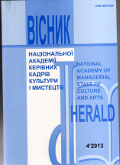Museum as a social institution of cultural representation on Bucovina: traditions and innovations
DOI:
https://doi.org/10.32461/2226-3209.4.2013.138017Keywords:
national cultural heritage, traditions, innovations, museum of local lore, art museum, exposure, open-air museum, Skansen, museum marketing and management, audio guideAbstract
In the article it is analyzed the peculiarities of the museum as a social institution of cultural representation on Bucovina in the aspects of traditions and innovations. It is investigated current trends of functioning of museums as socially cultural institutions, transformational processes in Museology in Bukovina, and also the introduction of new technologies and methods of work with visitors. Today, in the time of globalization and urbanization, the problem dealing with the preservation of national traditions and national identity of the person remains actual. This problem affects museum areas where you can the most clearly see the combination of past and present, traditional and innovative. Museology of modern Ukraine, focusing on European practice, is directed on the development in informationaly-cultural mainstream. In this context it is necessary to pay attention to the transformational processes in museum activities, where not only introduction of innovative methods and modern technologies occupies an important place, but also rethinking its traditional functioning. Museum of the XXI century began newly to influence on modern society, changed passive methods of work with visitors to the active, improved and modernized exposition, became the socio-cultural institution which should meet the needs of people with aesthetic, cultural and artistic knowledge as well as be a place of spiritual communication, creating intelligent individual. As a social institution, the museum has a unique value for each region. First of all, it is the center of scientific documentation and research activities in the region, since the selection, study and use of museum objects as artifacts require significant research, and the given results are often scientific discoveries. Museum is an institution of cultural representation of the region, because the museum exhibits are examples of cultural heritage and cultural norms that dominate in a particular area at a particular time. Continuing the traditions of the all-European integrational course, museums of Bucovina, one of the specific historically ethnographic regions of Ukraine, complement traditional forms of museums activities with modern forms, such as the introduction of new informational technologies, the use of museum management and marketing, creating a "virtual museums" and so on. Museums confirm Bukovina’s history from ancient times to the present day in many sites of antiquities. They outline the settlement of this region and the development of its natural resources, the evolution of Ukrainian culture within different states in the multilingual, multicultural and multiconfession conditions. The largest museum in Chernivtsi region, near 90,000 exhibits, is Chernivtsi Regional Museum. Its peculiarity is the fact that it is the first and oldest museum of Bukovina, which functioned during Austria-Hungary, Romania, and the Soviet Union domination and survived in two world wars. The employees of this museum try to find new forms and methods of work, "spice up" their collection, introduce modern multimedia technology and actively use the possibilities of the Internet. Museum, which in recent years the most actively takes part in the cultural life of Bukovina, is Chernivtsi art museum. Considering the new demands of modern society, the leadership of this museum attracts visitors through temporary experimental exhibitions, which popularize modern forms of art. Chernivtsi Art Museum begins to use modern museum marketing and management, which enable to attract investments for the implementation of museum projects, get charity and patronage. One of six Ukrainian open-air museums is located in Bukovina, and is called Chernivtsi Oblast Museum of Folk Architecture and Life. The administration of this institution is trying to make the museum more "alive" and close to visitors. To gain this aim they exploit new methods of using theatrical costumes, role play, principles of screenplay building of museum programs. In the open-air museum, except the usual excursions, they held various folkloreethnographic and ethno-spiritual holidays and festivals. Chernivtsi Oblast Museum of Folk Architecture and Life actively contributes in the revival and preservation processes of traditional customs and rituals, which is achieved by using both traditional and modern forms and methods of work with visitors and plays a significant role in the development of folk art and crafts in Bukovina. Museum politics of region tries to follow the new trends of the modern era, according to which the museum is no longer repository and research center, as the traditional concept represented it, but a tool of socially cultural changes, the space which is filled with emotions and debates not only about issues of culture and art, but everything that is the most interesting in the modern life.Downloads
Published
Issue
Section
License
Authors who publish with this journal agree to the following terms:
1. Authors retain copyright and grant the journal right of first publication with the work simultaneously licensed under a Creative Commons Attribution License International CC-BY that allows others to share the work with an acknowledgement of the work's authorship and initial publication in this journal.
2. Authors are able to enter into separate, additional contractual arrangements for the non-exclusive distribution of the journal's published version of the work (e.g., post it to an institutional repository or publish it in a book), with an acknowledgement of its initial publication in this journal.
3. Authors are permitted and encouraged to post their work online (e.g., in institutional repositories or on their website) prior to and during the submission process, as it can lead to productive exchanges, as well as earlier and greater citation of published work (See The Effect of Open Access).


